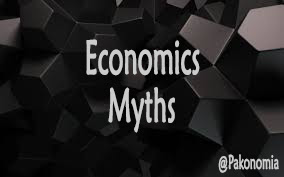1. The Myth of 'Economics Deals With Money'
This is the biggest myth of Economics where it is considered that this social scientific discipline deals with only money, banking and employment. However, It is a "Social" science that deals with the economic "behavior" of people who make optimal choices and decisions. David Autor, Professor at MIT, has described two common misconceptions concerning Economics. One amongst those misconceptions is that Economics is a science of money. He describes that
Many think that economics is just about money. That's not true. It's about decision-making---how people make decsions and how individual decisions aggregate up to collective outcomes that are often very different from what people are individually seeking
---David Autor
2. 'In the Long run, We Are Dead', A Myth
The second myth of Economics is that the consequences of any economic policies are seen only in the short run. The long-run effects are ignored as John M. Keynes said that
In the Long Run, We are Dead
While Economics has been regarded as a complex evolving system by Stiglitz, who is an American economist. The consumption decisions made today by governments can burden future generations with high levels of debts. The decisions we make about the use of products can have serious implication on the environment and on the health of future generations. Although, this statement of Keynes was about the natural rate of output and unemployment. It cannot be applied to the current economic systems where growth takes into account sustainable development.
3. The Myth of Increase In Income
It is possible that a nation has a high level of income and high inflation rates. High inflation rates offset the benefit of increased income as the prices of all other goods has also increased by the same level. The increase in income will benefit you if the inflation rates are lower or the prices of other things have not changed and remained the same.
4. The Myth of Printing Money
In most of the countries, it is a misconception and a myth that the government prints money to pay off debs and to reduce the budget deficit. But this is not true. Print money means the creation of money by the banking sector through the loan creation process. Banks create, or in other words, print money by lending money to consumers or investors. Government prints money and coins only to facilitate banks to fulfill the demand of money by the account holders. Another form of printing money by the government is the Treasury Bills or Bonds. Otherwise, all the "Print Money" process is actually performed by the banks. The myth of printing money can be alleviated by using the term "Money Multiplier" that better represents this concept.
5. 'Economics Has No Practical Implication' Myth
One of the horrible myth of all social sciences is that Economics has no practical implications. It is only assumptions-based and restricted to class and a teacher. Nevertheless, It has vital and crucial practical implications as described by Professor Autor. It has practical implications in production lines, globalization, political economy and for consumer theories. Recently, It has made important progress in behavioral economics where psychology has been applied to analyze economic behavior.
6. The Myth of Cheap Labour
In this century where the world has become a global village, the assembly process in production has expanded to other countries whereever is low-cast labor. The cheap labor is not because their wages are lower or because of weak labor unions. The reason for cheap labor in these countries is that their labor is not efficient or have lower productivity levels. Developed countries have higher wage rates as a result of higher productivity levels and more efficient.
7. The Myth of the Philips Curve
The myth of the Philips Curve shows a trade-off between inflation and unemployment. On the contrary, the historical analysis does not support such inversion and trade-off between these two macro variables. The Philips curve violates the theory of wages where higher wage rate leads to unemployment. While the Philips Curve assumes that higher wage rates reduce unemployment with no empirical evidence. The Philips Curve has long been dead and it must be removed from the Economics books as it is a dead piece with no practical implications.





2 Comments
An exceptional article.....
ReplyDeleteThank you 😊
Delete